Australia is known for its beautiful landscapes as much as it’s known for its deadly animals. Victoria is no exception. Located in southeastern Australia, Victoria has both mountains and coasts, making it home to a range of unique and deadly animals. Some are typical, like sharks, though there’s one on this list that might come as a surprise to you.
1. Eastern Brown Snake (Pseudonaja textiles)
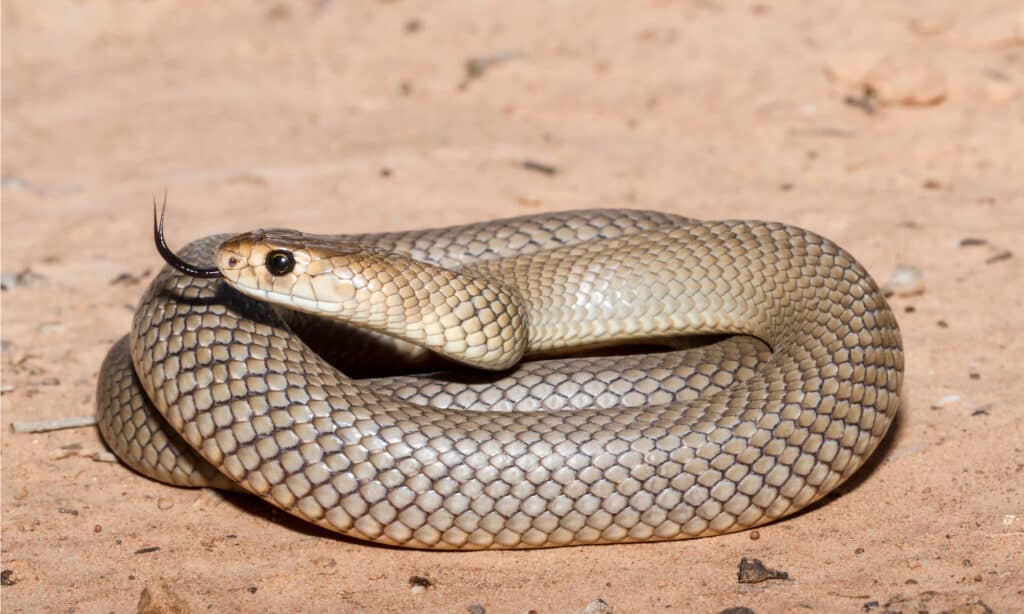
These snakes have obvious ridges above their eyes and live in open landscapes and urban areas.
©Ken Griffiths/Shutterstock.com
The Eastern brown snake is present almost everywhere in Australia and in most ecological habitats. They are the most encountered snakes on the continent and live alongside humans in most environments, making them one of Victoria’s deadliest animals. Identifying these creatures as a novice might be difficult: they are almost any shade of brown, smooth and glossy in appearance and texture, and have a small head, a light-colored belly, and orange irises. However, you shouldn’t get close enough to any snake you can’t positively identify to check their eye color!
Their defensive habits can range from flight mode when a distant threat is encountered to fight mode when cornered or surprised. It sounds comforting upon learning that their fangs are relatively small and venom delivery is minuscule, but what the Eastern brown snake lacks in volume it makes up for in the strength and danger of its venom. In addition to its potent venom, a victim might not even realize they were bitten. This can be attributed to their small fangs. Progressive effects of envenomation from this species can lead to uncontrollable blood loss, paralysis, and death.
Even though this snake is responsible for the most snake bite-related deaths in Australia, it turns out most of these bites and subsequent deaths could have been avoided. Simply put, if you see this type of snake, just leave it alone!
2. Redback Spiders (Latrodectus hasselti)
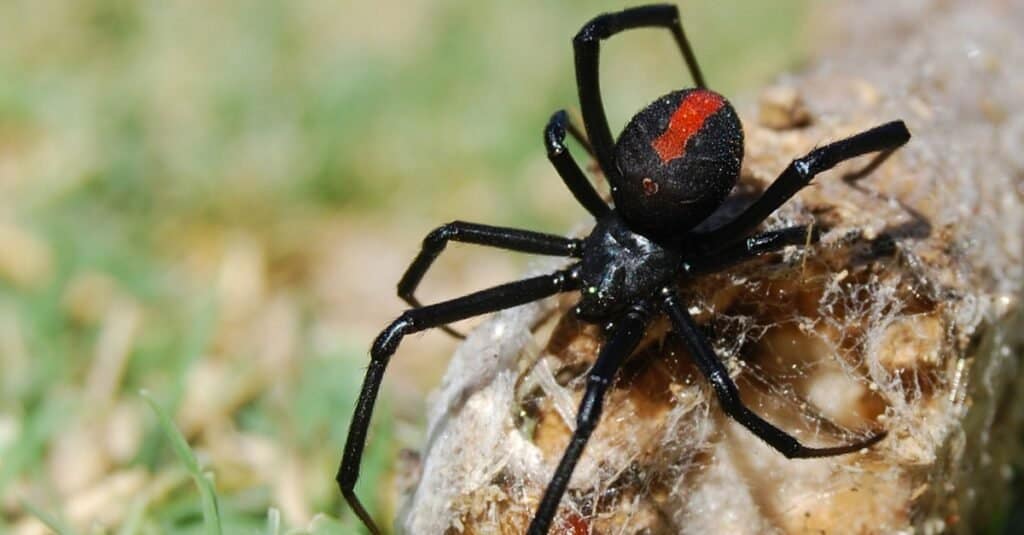
It can be easy to confuse the
redback spider
with a black widow since they both have the same coloration and similar markings.
©iStock.com/maria72
Spiders like the huntsman spider are widely present throughout Victoria and get a lot of press. While they are large and intimidating, they are not really a danger. Redback spiders on the other hand are actually one of the more deadly animals in Victoria to watch out for. In fact, female redback spiders are one of the most venomous spiders in existence. They look similar to a black widow, which gives it its other common name of “Australian black widow” as it features a red stripe along the back of its dark black body. The difference can be told by the shape of the red marking: a redback spider has a stripe, whereas a black widow has the infamous “hourglass” shape.
Redback spiders can live inside buildings but are also found in the environment living under rocks, logs, or debris. These spiders can bite multiple times, and while not every time might have venom, if it does, the venom can be very poisonous. The bite can cause sweating, nausea, headache, and of course, localized pain and swelling. Death might occur if anti-venom is not administered in time. Allergic reactions to the venom can also cause death. If bitten, it’s important to receive treatment with anti-venom to avoid feeling the full wrath of the redback spider.
3. Copperhead Snake, Highlands and Lowlands (Austrelaps ramsayi and Austrelaps superbus)
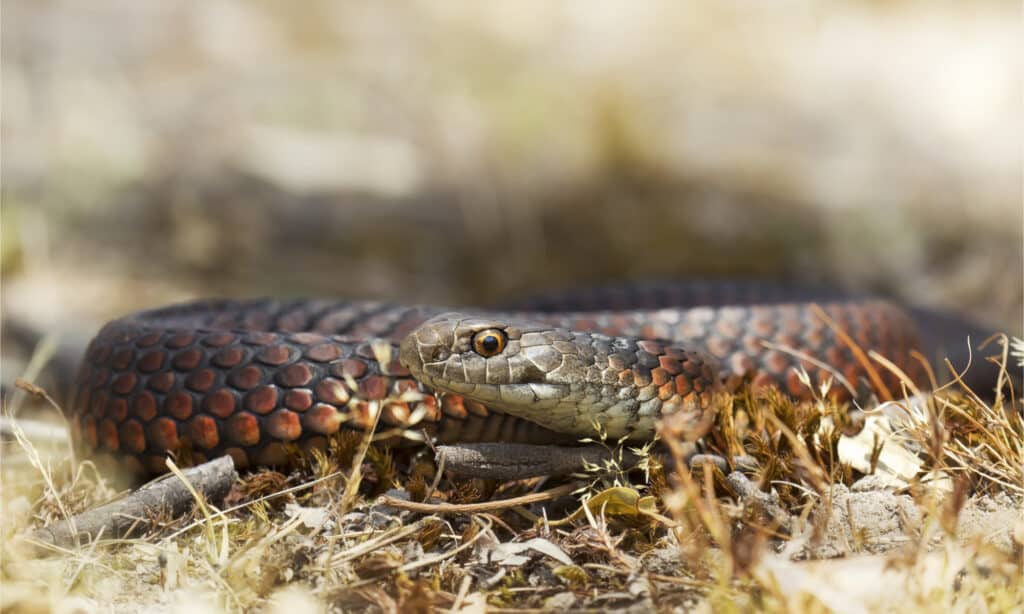
As if having to watch out for one species of copperhead snake wasn’t enough, Victoria has two species to be aware of!
©Austrelaps superbus/Shutterstock.com
Both of these species of Australian copperheads are dangerously venomous and should not be approached. The highlands copperhead is more common in eastern Victoria and lives mostly in open forests, woodlands, disturbed areas, and occasionally near water.
The lowlands species are more frequently present in southern Victoria in grasslands, marshes, swamps, and disturbed areas. They also might inhabit drainage ditches or abandoned tires, which could make accidentally stumbling upon one more likely.
The venom of both these species can be enough to be fatal if medical attention is not immediately obtained. Effects of the toxins can include damage to the circulatory system and nervous system, and can also affect cellular functions. Without anti-venom, a bite from an adult snake can easily be fatal.
The highlands and lowlands copperheads aren’t very aggressive and will prefer to flatten their bodies and hiss at intruders instead of immediately attacking. However, it’s best not to disturb these predators since they will definitely use their bite (and venom) as a last resort to protect themselves.
4. Blue-ringed Octopus (Hapalochlaena spp.)
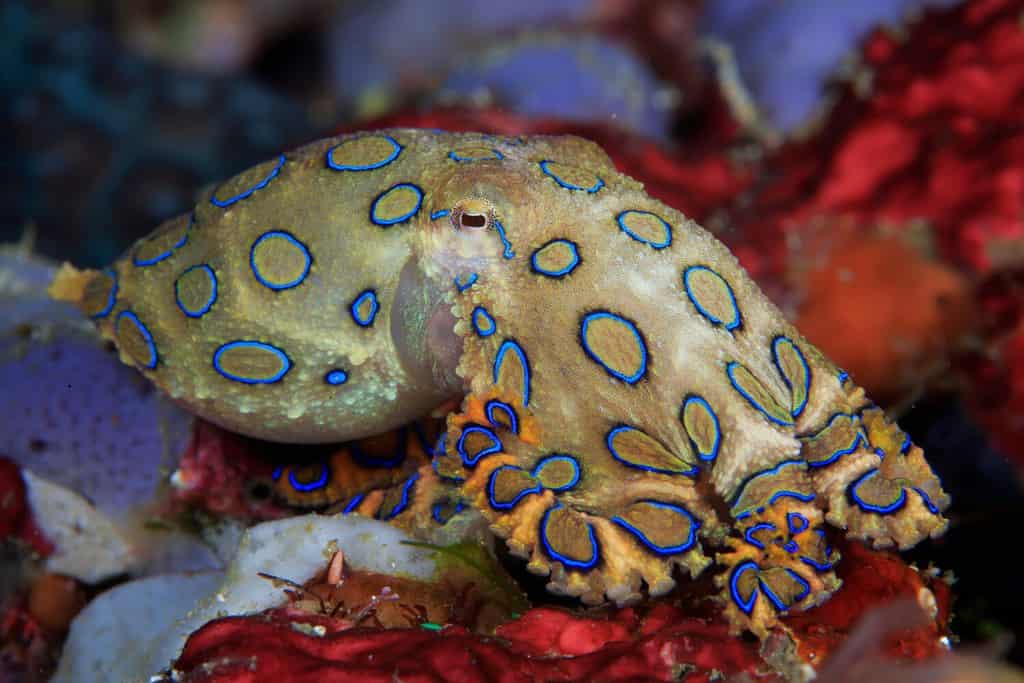
The “
blue-ringed octopus
” is a common name for multiple species in this deadly genus.
©Thierry Eidenweil/Shutterstock.com
Blue-ringed octopodes live along the southern coastline of Victoria and are amongst the most toxic animals in the ocean. They primarily reside in coral reefs and algal floors, but can also inhabit tide pools. The tiny scale of these creatures, along with their beautiful color display, makes them look alluring and innocent, but that could not be further from the truth.
These are small specimens that pack a big punch. The toxin present in the venom of the blue-ringed octopus contains tetrodotoxin (TTX) which can cause paralysis and, subsequently, death. The toxin can be injected into prey (or an unsuspecting human) through a bite or ingestion by consuming the animal. Either of these instances, fortunately, is quite rare. A good rule of thumb is to not touch or interact with animals you’re unfamiliar with, especially if they’re brightly colored!
5. Tiger Snake (Notechis scutatus)
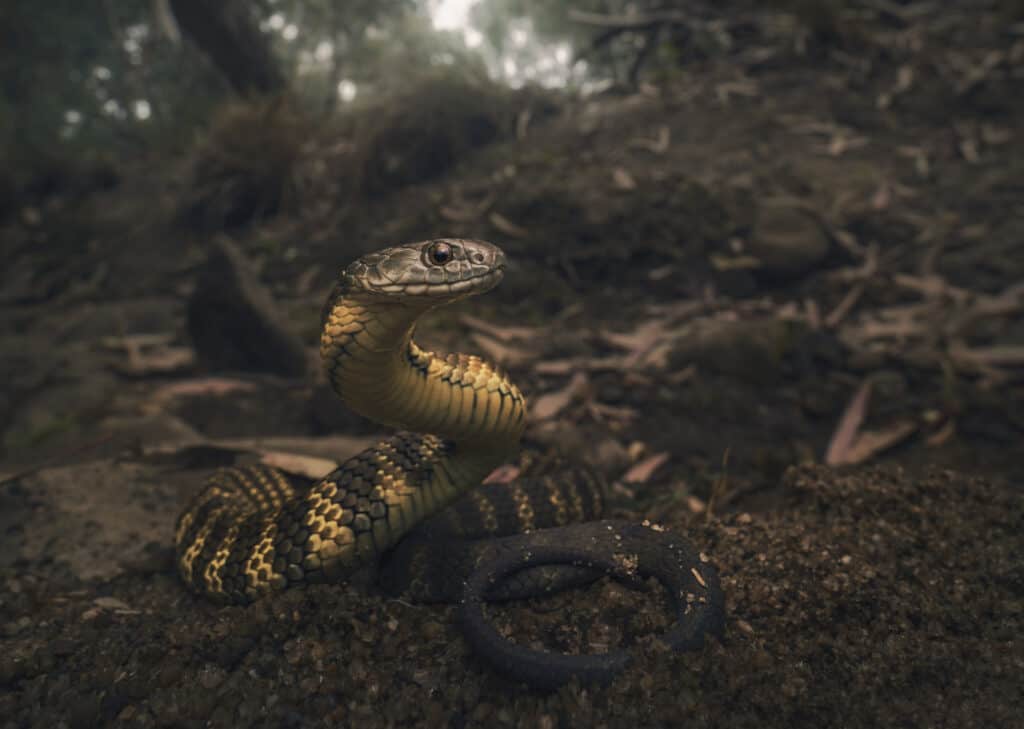
Their stripes are usually black. and yellow, though color variations could also be brownish with light yellow or whitish stripes.
©Kristian Bell/Shutterstock.com
Named “tiger snake” because of their prominent black and yellow stripes along their body, this large species of snake is just as feared. Tiger snakes are rather aggressive and have a deadly bite to back up their behavior. Their venom coagulates the blood and is highly neurotoxic, so seek immediate treatment if you have received a bite from one of these snakes.
While it is one of the deadliest animals in Victoria, it’s not very likely you will encounter a tiger snake. They often live in sheltered habitats or creeks and dams. Despite their aggression, they will give warning signals and a loud hiss before striking to fend off predators.
6. Great White Sharks (Carcharodon carcharias)

Great whites are majestic and deadly creatures found in Victorian waters.
©Willyam Bradberry/Shutterstock.com
It goes without saying that no matter where you are geographically, a great white shark is a dangerous and deadly creature. They are fast and powerful ambush predators that emerge from seemingly out of nowhere to attack their prey from below. Australia’s coasts are known hotspots for great white activity.
Attacks from sharks actually don’t happen very often in Victoria, but that doesn’t mean their presence in the area is minimal. Though these are some of the most deadly and fearsome creatures, they’re relatively easy to avoid. By swimming in patrolled beach areas and staying out of the water at dusk and dawn, the chances of being attacked can be drastically reduced. In fact, there has not been a fatal shark attack in Victoria since 1987.
7. Tiger Sharks (Galeocerdo cuvier)
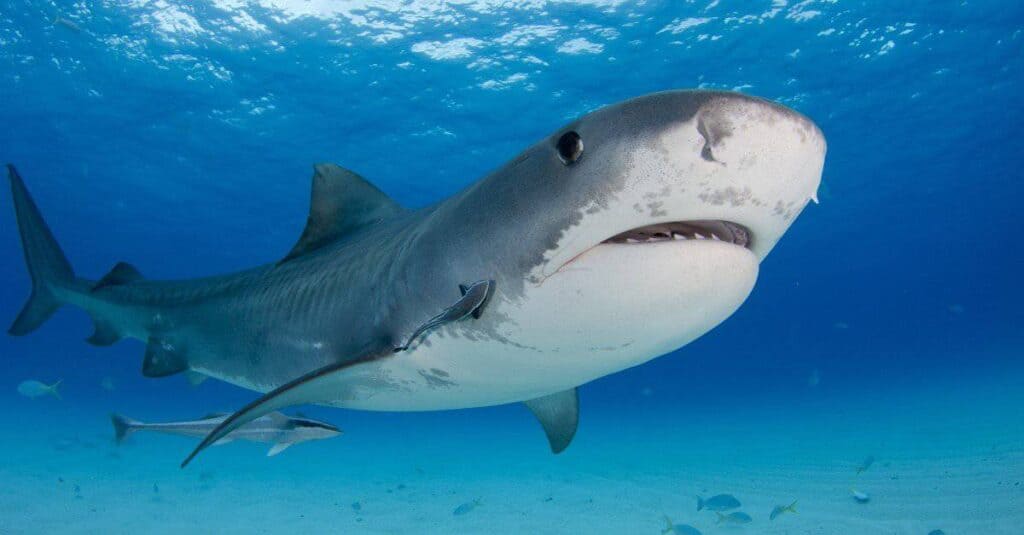
Tiger sharks are notorious for eating just about anything, including license plates and even tires!
©Matt9122/Shutterstock.com
A tiger shark is one of the deadliest animals off the coast of Victoria. Their appetite and lack of “choosiness” when it comes to what they eat makes these oceanic predators a threat to beachgoers and swimmers.
The good news is that tiger sharks most actively feed at night, making them relatively easy to avoid. If you stick with swimming off Victoria’s northern coast, you might have even less of a chance of encountering this type of shark. With that being said, they do tend to hang out around shallow waters more than some of their other shark counterparts, so always proceed with caution when entering the water.
However, if you never go into the ocean you will have a 0% chance of encountering any of the deadly sea animals on this list, which explains why sharks are not higher on this list.
8. Bronze Whaler (Carcharhinus brachyurus)

These sharks are named for their bronze-colored upper body with black tips on their fins.
©Sean Steininger/Shutterstock.com
Another shark but not as big of a name (or reputation), the bronze whaler can also pose a threat to spearhunters or unsuspecting swimmers. Bronze whalers are not aggressive, though they are plentiful around the shoreline. This can cause issues with spearfishers with recent catches, as fish in distress or fresh catches will attract these sharks (and others).
Taking precautions while swimming, surfing, and fishing are necessary to avoid a bite from curious creatures of the sea.
9. Kangaroos (Macropus spp.)
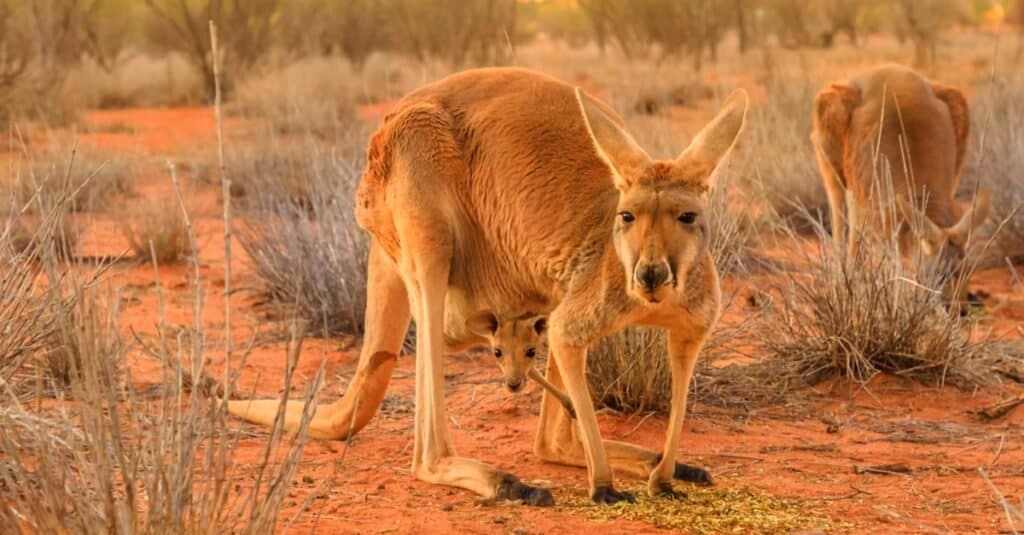
Kangaroos
are absolutely adorable animals, though this doesn’t mean they’re friendly or safe to interact with.
©Benny Marty/Shutterstock.com
Almost a mascot of Australia, kangaroos are mostly shy and timid creatures. There are four species of kangaroos, all of which inhabit Australia. Despite their cute appearance and bashful demeanor, they can be aggressive and attack humans. If this happens, their powerful kicks and sharp claws can do a lot of damage to a human or pet.
It’s best to avoid direct contact with wildlife in any and all circumstances. If there is an instance where a kangaroo is acting aggressively towards you, the move to make is one that makes you seem non-threatening. Crouching and moving away or hiding is your best bet (aka, getting out of the situation as soon as possible). It’s also important to keep your dogs away from the animals, as they can be very aggressive towards dogs.
Avoid standing tall or “challenging” the kangaroo. This can include walking quickly towards the animal or generally staring too long. These actions provoke the animal which might end badly for the human involved. As with most other animals, do not approach them when mating, courting another kangaroo, or with their young. These are times when kangaroos are most on edge and are likely to protect themselves, potential mates, and/or their offspring.
10. Australian Magpies (Gymnorhina tibicen)
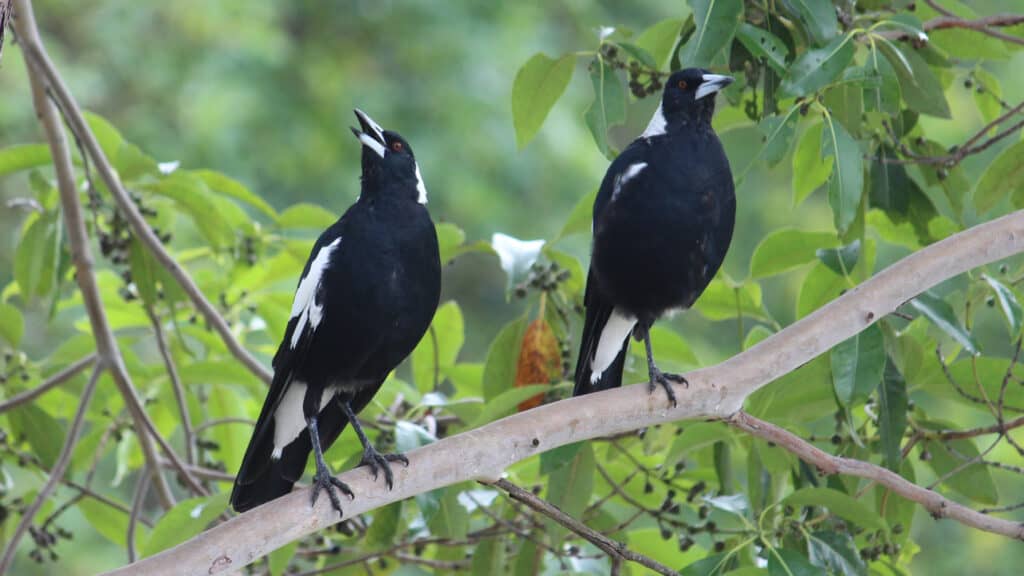
Birds, especially of this size, might not make you think you’d be in danger around them, but Australian magpies might make you think again.
©Rose Makin/Shutterstock.com
What might come as a surprise to you is one of Victoria’s most dangerous animals is a 15-inch-long bird! While the Australian magpie might not be immediately one of the deadliest animals in Victoria, they have the potential to cause great harm or damage to passersby. This bird is particularly aggressive during breeding season, which is August-October. People walking or cyclists traveling through and around areas where these birds nest could be prime victims for attacking. These swooping scare tactics are usually just to scare away potential predators to their offspring, but sometimes it becomes something more.
Injuries from claws or beaks are commonplace if an Australian magpie makes physical contact with you. To avoid the wrath of these birds, avoid walking or cycling in areas where they nest. If that’s not possible, dismount from your bike and walk your bike along the way. Umbrellas can also be helpful to deter their advances. If you are attacked, try to stay calm and protect your head and face while you walk away. Waving your arms might further provoke the bird.
| Top 10 Deadliest Animals in Victoria |
|---|
| 1. Eastern brown snake |
| 2. Redback spider |
| 3. Copperhead snake (Highlands and Lowlands) |
| 4. Blue-ringed octopus |
| 5. Tiger snake |
| 6. Great white shark |
| 7. Tiger shark |
| 8. Bronze whaler |
| 9. Kangaroos |
| 10. Australian Magpie |
The photo featured at the top of this post is © iStock.com/slowmotiongli
Thank you for reading! Have some feedback for us? Contact the AZ Animals editorial team.






